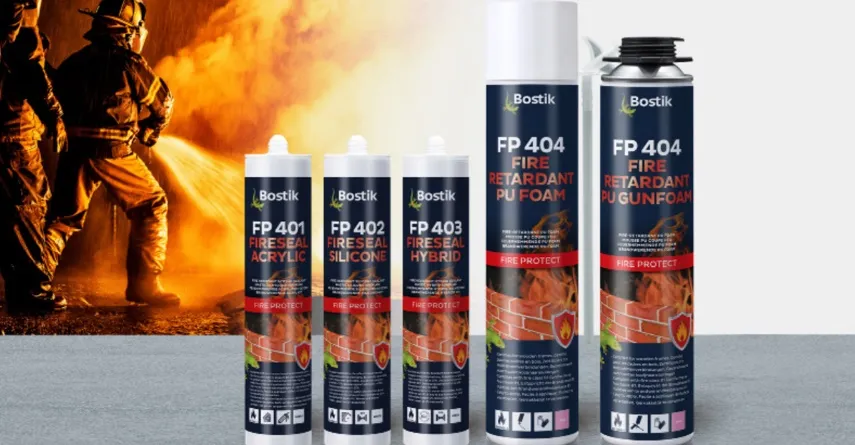Most people are aware of the basics of fire suppression, such as sprinklers and fire extinguishers, but passive fire protection that contains a fire at its source might be unseen and practically forgotten – until the day you realize how important it is.

Engineer Jethro Ramirez, Technical Business Development Manager for Bostik Asia Pacific, stressed the importance of passive fire prevention in safeguarding both building inhabitants and firefighters during his webinar on Passive Fire Protection for Better Building Safety on April 25.
What is Passive Fire Protection (PFP)?
Passive fire protection does not aim to put out a fire but to prevent or minimize its spread through the deployment of fireproof systems, such as fire-resistant walls and other proactive compartmentalization measures.
Passive fire protection (PFP) systems, contrary to their name, are always at work behind the scenes if properly installed and maintained. While we often overlook PFP systems in front of active fire protection (AFP), they are an essential component of any fully integrated fire prevention system.
Business and building owners that recognize the importance of passive fire protection for their facility are better positioned to work with an expert fire protection provider who can design, install, inspect, maintain, and monitor a full fire protection system adapted to their requirements.
Areas of Passive Fire Protection
We can break down passive fire protection into four main areas.
Structural Fire Protection
To safeguard critical structural components (such as structural steel and joint systems) from fire, structural fire protection is required.
This can be done with fireproofing material (spray-on thin-film intumescents, endothermic materials like gypsum-based plasters and cementitious products, mineral wool wraps and insulation, and fireproofing cladding) or by using concrete goods to build the structure.
Compartmentation
Compartmentation includes fire barriers, firewalls, fire partitions, and smoke barriers.
According to Engr. Ramirez, the primary premise of compartmentation is to compartmentalize or confine a fire so that it does not spread to neighboring areas, which is especially crucial in condominiums.
Fire-resistant walls, floors, and ceilings are examples of fire barriers which are often made of concrete, combination wood, gypsum, or masonry. These barriers keep fire from spreading across a structure and allow for a safe exit. For complete protection, walls extend from a fire-rated floor to the fire-rated ceiling above and continue into concealed compartments.
Opening Protection
To maintain a fire barrier’s resistance, fire doors and windows are fitted in its openings.
Fire-rated glazing/glass and framing are evaluated as a complete assembly to ensure that fire barrier is maintained. Also known as “opening protection,” fire and smoke dampers, typically found in duct systems, complete the fire barrier where air ducts pierce fire-rated and/or smoke-resistant assemblies.
Firestopping Materials
These materials are used to keep fire from spreading through a fire barrier. It will render the fire barrier less effective if penetration is not properly sealed and covered with a suitable firestop system, and fire will spread beyond the compartment of origin.
Bostik’s Application Segment Passive Fire Protection
Passive fire protection systems that are implemented and maintained correctly give building occupants vital time to leave the facility by containing the fire for a longer period. Bostik’s application range in the Passive Fire Protection category has a lot to offer in that regard.
Safety comes first for Bostik. All Bostik’s passive fire protection ideas have been fully tested and certified. Preparing for things that you hope never happen is a good idea. But if something bad happens, Bostik products for linear joints and surface penetrations help emergency workers save more lives and keep more people safe.
Bostik’s Passive Fire Protection offering comprises fully certified products for linear joints (EN 1366-4) and service penetrations (EN 1366-3).
Bostik Linear Joints Solutions
The walls and floors of a fire compartment are made of fire-resistant materials. A sound fire-resistant seal of joints between these walls and floors completes a compartment. The structure’s couplings with the (fire) doors and (window) frames must also be fire-resistant. EN 1366-4-certified products and systems are used to seal fire compartments where walls, frames, and floors intersect. Most of these goods and systems were made to absorb movement in construction components.
What are Bostik’s solutions to linear joints?
Bostik FP 401 Fireseal Acrylic

The Bostik FP401 FIRESEAL ACRYLIC was crafted for sealing linear connection joints in gypsum and stony substrates.
Bostik FP 402 Fireseal Silicone

The Bostik FP402 FIRESEAL SILICONE was developed specifically for fire-resistant sealing of connection and expansion joints in construction and is fire resistant in the event of a fire. Prevents fire, smoke, or poisonous gasses from spreading.
Bostik FP 403 Fireseal Hybrid

The Bostik FP403 FIRESEAL HYBRID was created specifically for fire-resistant sealing of connection and expansion joints in construction that must have a certain fire resistance and prevent the spread of fire, smoke, and hazardous gasses in the event of a fire. Horizontal joints, floor/ceiling to wall connections, wood and steel frames, stony substrates, and all metal-stud applications are also certified.
Bostik FP 404 Fire Retardant PU (Gun)Foam

The Bostik FP404 FIRE RETARDANT PU FOAM was specifically created for the sealing and filling of joints and seams in situations where fire resistance is required.
Are you interested in learning more about Bostik’s Passive Fire Protection portfolio? Register now for the Bostik ACADEMY training program, which is completely free!










